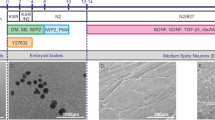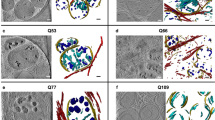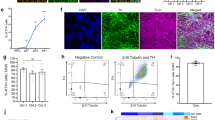Abstract
Calcium, the most versatile second messenger, regulates essential biology including crucial cellular events in embryogenesis. We investigated impacts of calcium channels and purinoceptors on neuronal differentiation of normal mouse embryonic stem cells (ESCs), with outcomes being compared to those of in vitro models of Huntington’s disease (HD). Intracellular calcium oscillations tracked via real-time fluorescence and luminescence microscopy revealed a significant correlation between calcium transient activity and rhythmic proneuronal transcription factor expression in ESCs stably expressing ASCL-1 or neurogenin-2 promoters fused to luciferase reporter genes. We uncovered that pharmacological manipulation of L-type voltage-gated calcium channels (VGCCs) and purinoceptors induced a two-step process of neuronal differentiation. Specifically, L-type calcium channel-mediated augmentation of spike-like calcium oscillations first promoted stable expression of ASCL-1 in differentiating ESCs, which following P2Y2 purinoceptor activation matured into GABAergic neurons. By contrast, there was neither spike-like calcium oscillations nor responsive P2Y2 receptors in HD-modeling stem cells in vitro. The data shed new light on mechanisms underlying neurogenesis of inhibitory neurons. Moreover, our approach may be tailored to identify pathogenic triggers of other developmental neurological disorders for devising targeted therapies.
This is a preview of subscription content, access via your institution
Access options
Subscribe to this journal
Receive 12 print issues and online access
$259.00 per year
only $21.58 per issue
Buy this article
- Purchase on Springer Link
- Instant access to full article PDF
Prices may be subject to local taxes which are calculated during checkout





Similar content being viewed by others
References
Rossant J, Tam PP. Blastocyst lineage formation, early embryonic asymmetries and axis patterning in the mouse. Development. 2009;136:701–13.
Huang G, Ye S, Zhou X, Liu D, Ying QL. Molecular basis of embryonic stem cell self-renewal: from signaling pathways to pluripotency network. Cell Mol Life Sci. 2015;72:1741–57.
ten Berge D, Koole W, Fuerer C, Fish M, Eroglu E, Nusse R. Wnt Signaling Mediates Self-Organization and Axis Formation in Embryoid Bodies. Cell Stem Cell. 2008. https://doi.org/10.1016/j.stem.2008.09.013.
Dhara SK, Stice SL. Neural differentiation of human embryonic stem cells. J Cell Biochem. 2008;105:633–40.
Ulrich H, Majumder P. Neurotransmitter receptor expression and activity during neuronal differentiation of embryonal carcinoma and stem cells: from basic research towards clinical applications. Cell Prolif. 2006;39:281–300.
Perrier AL, Tabar V, Barberi T, Rubio ME, Bruses J, Topf N, et al. Derivation of midbrain dopamine neurons from human embryonic stem cells. Proc Natl Acad Sci USA. 2004. https://doi.org/10.1073/pnas.0404700101.
Chuang JH, Tung LC, Lin Y. Neural differentiation from embryonic stem cells in vitro: an overview of the signaling pathways. World J Stem Cells. 2015;7:437–47.
Resende RR, Britto LRG, Ulrich H Pharmacological properties of purinergic receptors and their effects on proliferation and induction of neuronal differentiation of P19 embryonal carcinoma cells. Int J Dev Neurosci. 2008. https://doi.org/10.1016/j.ijdevneu.2008.07.008.
Resende RR, Adhikari A, da Costa JL, Lorencon E, Ladeira MS, Guatimosim S, et al. Influence of spontaneous calcium events on cell-cycle progression in embryonal carcinoma and adult stem cells. Biochim Biophys Acta. 2009;1803:246–60.
Zimmermann H. Purinergic signaling in neural development. Semin Cell Dev Biol. 2011;22:194–204.
Neary JT, Zimmermann H. Trophic functions of nucleotides in the central nervous system. Trends Neurosci. 2009;32:189–98.
Oliveira A, Illes P, Ulrich H. Purinergic receptors in embryonic and adult neurogenesis. Neuropharmacology. 2016;104:272–81.
Illes P, Rubini P. Regulation of neural stem/progenitor cell functions by P2X and P2Y receptors. Neural Regen Res. 2017;12:395–6.
Tang Y, Illes P. Regulation of adult neural progenitor cell functions by purinergic signaling. Glia. 2017;65:213–30.
Burnstock G, Knight GE. Cellular distribution and functions of P2 receptor subtypes in different systems. Int Rev Cytol. 2004;240:31–304.
Burnstock G. Purine and pyrimidine receptors. Cell Mol Life Sci. 2007;64:1471–83.
Verkhratsky A, Krishtal OA, Burnstock G. Purinoceptors on neuroglia. Mol Neurobiol. 2009;39:190–208.
Dubyak GR, el-Moatassim C. Signal transduction via P2-purinergic receptors for extracellular ATP and other nucleotides. Am J Physiol. 1993;265:C577–606.
Spitzer NC, Lautermilch NJ, Smith RD, Gomez TM. Coding of neuronal differentiation by calcium transients. Bioessays. 2000;22:811–7.
Ulrich H, Abbracchio MP, Burnstock G. Extrinsic purinergic regulation of neural stem/progenitor cells: implications for CNS development and repair. Stem Cell Rev. 2012;8:755–67.
Spitzer NC, Root CM, Borodinsky LN. Orchestrating neuronal differentiation: patterns of Ca2+spikes specify transmitter choice. Trends Neurosci. 2004;27:415–21.
Resende RR, da Costa JL, Kihara AH, Adhikari A, Lorençon E. Intracellular Ca2+ regulation during neuronal differentiation of murine embryonal carcinoma and mesenchymal stem cells. Stem Cells Dev. 2010. https://doi.org/10.1089/scd.2008.0289.
Berridge MJ, Lipp P, Bootman MD. The versatility and universality of calcium signalling. Nat Rev Mol Cell Biol. 2000;1:11–21.
Lipp P, Thomas D, Berridge MJ, Bootman MD. Nuclear calcium signalling by individual cytoplasmic calcium puffs. EMBO J. 1997;16:7166–73.
Spitzer NC. Activity-dependent neuronal differentiation prior to synapse formation: the functions of calcium transients. J Physiol Paris. 2002;96:73–80.
Tonelli FM, Santos AK, Gomes DA, da Silva SL, Gomes KN, Ladeira LO, et al. Stem cells and calcium signaling. Adv Exp Med Biol. 2012;740:891–916.
Leclerc C, Néant I, Webb SE, Miller AL, Moreau M. Calcium transients and calcium signalling during early neurogenesis in the amphibian embryo Xenopus laevis. 2006 Biochimica et Biophysica Acta (BBA) - Molecular Cell Research. 1763:1184–91.
Weber AM, Wong FK, Tufford AR, Schlichter LC, Matveev V, Stanley EF. N-type Ca2+ channels carry the largest current: Implications for nanodomains and transmitter release. Nat Neurosci. 2010;13:1348–50.
Weiss N. The N-type voltage-gated calcium channel: when a neuron reads a map. J Neurosci. 2008;28:5621–2.
Gray EE, Murphy JG, Liu Y, Trang I, Tabor GT, Lin L, et al. Disruption of GpI mGluR-dependent Cav2.3 translation in a mouse model of fragile X syndrome. J Neurosci. 2019;39:7453–64.
Moody WJ. 5 The development of voltage-gated Ion channels and its relation to activity-dependent developmental events. Curr Top Dev Biol. 1998;39:159–85.
Snutch TP. Voltage-gated calcium channels. Encycl Neurosci. 2009;1:427–41.
Cao YQ, Tsien RW. Different relationship of N- and P/Q-type Ca2+ channels to channel-interacting slots in controlling neurotransmission at cultured hippocampal synapses. J Neurosci. 2010;30:4536–46.
Vonsattel JP, DiFiglia M. Huntington disease. J Neuropathol Exp Neurol. 1998;57:369–84.
Pchitskaya E, Popugaeva E, Bezprozvanny I. Calcium signaling and molecular mechanisms underlying neurodegenerative diseases. Cell Calcium. 2017;70:87–94.
MacDonald Gillian P. Buckler, Altherr Alan J, Michael Tagle Danilo Snell. A novel gene containing a trinucleotide repeat that is expanded and unstable on Huntington’s disease chromosomes. The Huntington’s Disease Collaborative Research Group. Cell. 1993;72:971–83.
Langbehn DR, Brinkman RR, Falush D, Paulsen JS, Hayden MR. A new model for prediction of the age of onset and penetrance for Huntington’s disease based on CAG length. Clin Genet. 2004;65:267–77.
Hooper M, Hardy K, Handyside A, Hunter S, Monk M. HPRT-deficient (Lesch-Nyhan) mouse embryos derived from germline colonization by cultured cells. Nature. 1987;326:292–5.
Magin TM, Mcwhir J, Melton DW A new mouse embryonic stem cell line with good germ line contribution and gene targeting frequency. Nucleic Acids Res. 1992. https://doi.org/10.1093/nar/20.14.3795.
Fornazari M, Nascimento IC, Nery AA, da Silva CC, Kowaltowski AJ, Ulrich H. Neuronal differentiation involves a shift from glucose oxidation to fermentation. J Bioenerg Biomembr. 2011;43:531–9.
Young MT, Pelegrin P, Surprenant A. Amino acid residues in the P2X7 receptor that mediate differential sensitivity to ATP and BzATP. Mol Pharmacol. 2007;71:92–100.
Glaser T, De Oliveira SLB, Cheffer A, Beco R, Martins P, Fornazari M, et al. Modulation of mouse embryonic stem cell proliferation and neural differentiation by the P2X7 receptor. PLoS ONE. 2014;9:e96281.
Negraes PD, Lameu C, Hayashi MA, Melo RL, Camargo AC, Ulrich H. The snake venom peptide Bj-PRO-7a is a M1 muscarinic acetylcholine receptor agonist. Cytom A. 2011;79:77–83.
Sykes DA, Dowling MR, Charlton SJ. Exploring the mechanism of agonist efficacy: a relationship between efficacy and agonist dissociation rate at the muscarinic M3 receptor. Mol Pharmacol. 2009;76:543–51.
Pal R, Mamidi MK, Das AK, Rao M, Bhonde R. Development of a multiplex PCR assay for characterization of embryonic stem cells. Methods Mol Biol. 2013;1006:147–66.
Avelar GM, Glaser T, Leonard G, Richards TA, Ulrich H, Gomes SL A cyclic GMP-dependent K+ channel in the blastocladiomycete fungus Blastocladiella emersonii. Eukaryot Cell. 2015. https://doi.org/10.1128/EC.00087-15.
Imayoshi I, Isomura A, Harima Y, Kawaguchi K, Kori H, Miyachi H, et al. Oscillatory control of factors determining multipotency and fate in mouse neural progenitors. Science. 2013;342:1203–8.
Liu Y, Liu H, Sauvey C, Yao L, Zarnowska ED, Zhang SC. Directed differentiation of forebrain GABA interneurons from human pluripotent stem cells. Nat Protoc. 2013;8:1670–9.
Roy NS, Wang S, Jiang L, Kang J, Benraiss A, Harrison-Restelli C, et al. In vitro neurogenesis by progenitor cells isolated from the adult human hippocampus. Nat Med. 2000. https://doi.org/10.1038/73119.
Grimm I, Ullsperger SN, Zimmermann H. Nucleotides and epidermal growth factor induce parallel cytoskeletal rearrangements and migration in cultured adult murine neural stem cells. Acta Physiol. 2010;199:181–9.
D’Ascenzo M, Piacentini R, Casalbore P, Budoni M, Pallini R, Azzena GB, et al. Role of L-type Ca2+ channels in neural stem/progenitor cell differentiation. Eur J Neurosci. 2006;23:935–44.
Cheung KK, Ryten M, Burnstock G. Abundant and dynamic expression of G protein-coupled P2Y receptors in mammalian development. Dev Dyn. 2003;228:254–66.
Resende RR, Majumder P, Gomes KN, Britto LR, Ulrich H. P19 embryonal carcinoma cells as in vitro model for studying purinergic receptor expression and modulation of N-methyl-D-aspartate-glutamate and acetylcholine receptors during neuronal differentiation. Neuroscience. 2007;146:1169–81.
Malmersjo S, Liste I, Dyachok O, Tengholm A, Arenas E, Uhlen P. Ca2+ and cAMP signaling in human embryonic stem cell-derived dopamine neurons. Stem Cells Dev. 2013;19:1355–64.
Lautermilch NJ, Spitzer NC. Regulation of calcineurin by growth cone calcium waves controls neurite extension. J Neurosci. 2000;20:315–25.
Liu YP, Yang CS, Chen MC, Sun SH, Tzeng SF. Ca2+-dependent reduction of glutamate aspartate transporter GLAST expression in astrocytes by P2X7 receptor-mediated phosphoinositide 3-kinase signaling. J Neurochem. 2010. https://doi.org/10.1111/j.1471-4159.2010.06589.x.
Naranjo JR, Mellström B. Ca2+-dependent transcriptional control of Ca2+ homeostasis. J Biol Chem. 2012;287:31674–80.
Nieto M, Schuurmans C, Britz O, Guillemot F. Neural bHLH genes control the neuronal versus glial fate decision in cortical progenitors. Neuron. 2001;29:401–13.
Bertrand N, Castro DS, Guillemot F. Proneural genes and the specification of neural cell types. Nat Rev Neurosci. 2002;3:517–30.
Sung MH, McNally JG. Live cell imaging and systems biology. Wiley Interdiscip Rev Syst Biol Med. 2011;3:167–82.
Wheeler DG, Barrett CF, Groth RD, Safa P, Tsien RW. CaMKII locally encodes L-type channel activity to signal to nuclear CREB in excitation-transcription coupling. J Cell Biol. 2008;183:849–63.
Bito H, Deisseroth K, Tsien RW. CREB phosphorylation and dephosphorylation: a Ca(2+)- and stimulus duration-dependent switch for hippocampal gene expression. Cell. 1996;87:1203–14.
Ciccolini F, Collins TJ, Sudhoelter J, Lipp P, Berridge MJ, Bootman MD. Local and global spontaneous calcium events regulate neurite outgrowth and onset of GABAergic phenotype during neural precursor differentiation. J Neurosci. 2018. https://doi.org/10.1523/jneurosci.23-01-00103.2003.
Poulter MO, Barker JL, O’Carroll AM, Lolait SJ, Mahan LC. Differential and transient expression of GABAA receptor alpha-subunit mRNAs in the developing rat CNS. J Neurosci. 1992;12:2888–900.
Poulter MO, Barker JL, O’Carroll AM, Lolait SJ, Mahan LC. Co-existent expression of GABAA receptor beta 2, beta 3 and gamma 2 subunit messenger RNAs during embryogenesis and early postnatal development of the rat central nervous system. Neuroscience. 1993;53:1019–33.
Ma W, Barker JL. GABA, GAD, and GABA(A) receptor α4, β1, and γ1 subunits are expressed in the late embryonic and early postnatal neocortical germinal matrix and coincide with gliogenesis. Microsc Res Tech. 1998. https://doi.org/10.1002/10.1002/(SICI)1097-0029(19980301)40:5<398::AID-JEMT6>3.0.CO;2-N.
Ma W, Barker JL. Complementary expressions of transcripts encoding GAD67 and GABAA receptor alpha 4, beta 1, and gamma 1 subunits in the proliferative zone of the embryonic rat central nervous system. J Neurosci. 1995;15:2547–60.
Owens DF, Boyce LH, Davis MB, Kriegstein AR. Excitatory GABA responses in embryonic and neonatal cortical slices demonstrated by gramicidin perforated-patch recordings and calcium imaging. J Neurosci. 1996;16:6414–23.
LoTurco JJ, Owens DF, Heath MJS, Davis MBE, Kriegstein AR GABA and glutamate depolarize cortical progenitor cells and inhibit DNA synthesis. Neuron. 1995. https://doi.org/10.1016/0896-6273(95)90008-X.
Behar TN, Schaffner AE, Scott CA, O’Connell C, Barker JL Differential Response of Cortical Plate and Ventricular Zone Cells to GABA as a Migration Stimulus. J Neurosci. 2018. https://doi.org/10.1523/jneurosci.18-16-06378.1998.
Maric D, Liu QY, Maric I, Chaudry S, Chang YH, Smith SV, et al. GABA expression dominates neuronal lineage progression in the embryonic rat neocortex and facilitates neurite outgrowth via GABA(A) autoreceptor/Cl- channels. J Neurosci. 2001;21:2343–60.
Ben-Ari Y. Excitatory actions of GABA during development: the nature of the nurture. Nat Rev Neurosci. 2002;3:728–39.
Kleppner SR, Tobin AJ. GABA signalling: therapeutic targets for epilepsy, Parkinson’s disease and Huntington’s disease. Expert Opin Ther Targets. 2001;5:219–39.
Hodges A, Strand AD, Aragaki AK, Kuhn A, Sengstag T, Hughes G, et al. Regional and cellular gene expression changes in human Huntington’s disease brain. Hum Mol Genet. 2006. https://doi.org/10.1093/hmg/ddl013.
Anacker C, Hen R. Adult hippocampal neurogenesis and cognitive flexibility-linking memory and mood. Nat Rev Neurosci. 2017;18:335–46.
Shin E, Palmer MJ, Li M, Fricker RA. GABAergic neurons from mouse embryonic stem cells possess functional properties of striatal neurons in vitro, and develop into striatal neurons in vivo in a mouse model of Huntington’s disease. Stem Cell Rev Reports. 2012. https://doi.org/10.1007/s12015-011-9290-2.
Sailor KA, Lledo PM. Youth comes but once in a lifetime for adult-born neurons. Trends Neurosci. 2018;41:563–6.
Kempermann G, Gage FH, Aigner L, Song H, Curtis MA, Thuret S, et al. Human adult neurogenesis: evidence and remaining questions. Cell Stem Cell. 2018;23:25–30.
Acknowledgements
We thank Adriana Yamaguti Matsukuma, Denise Yamamoto, Wilton José da Rocha Lima and Zilda Mendonça Izzo for technical assistance, Prof. Deborah Schechtman, Department of Biochemistry, Institute of Chemistry, University of São Paulo, for donating the E14Tg2A cell line and Prof. Dr. Soraya Smaili, Federal University of São Paulo for donating the Q23 and Q74 plasmids. This work was supported by the Brazilian funding agencies Conselho Nacional de Desenvolvimento Científico e Tecnológico (CNPq) (grant number 467465/2014–2), INCT-REGENERA (National Institute of Science and Technology) and the Fundação de Amparo à Pesquisa do Estado de São Paulo (FAPESP) (grant numbers 2012/50880–4, 2015/13345–1, 2010/50554–4 and 2018/07366–4). Japanese grants included a Grant-in-Aid for Scientific Research on Innovative Areas (Ministry of Education, Culture, Sports, Science, and Technology 16H06480) (RK), a Scientific Research (A) grant (Japan Society for Promotion of Science [JSPS] 24240049) (RK), a Young Scientists (A) grant (JSPS 24680035) (II), and a Takeda Foundation grant (RK). US grants that facilitated the project were W81XWH-15-1-0621 (DoD), 1-I01-RX000308-01A1 (VA), and funds from The Gordon Project to Cure Clinical Paralysis and Cele H. and William B. Rubin Family Fund, Incorporated (YDT). The funders had no role in the study design, data collection and analysis, decision to publish, or preparation of the manuscript.
Author information
Authors and Affiliations
Corresponding author
Ethics declarations
Conflict of interest
HU receives consulting fees and support from TissueGnostics GmbH, Vienna, Austria.
Additional information
Publisher’s note Springer Nature remains neutral with regard to jurisdictional claims in published maps and institutional affiliations.
Rights and permissions
About this article
Cite this article
Glaser, T., Shimojo, H., Ribeiro, D.E. et al. ATP and spontaneous calcium oscillations control neural stem cell fate determination in Huntington’s disease: a novel approach for cell clock research. Mol Psychiatry 26, 2633–2650 (2021). https://doi.org/10.1038/s41380-020-0717-5
Received:
Revised:
Accepted:
Published:
Issue Date:
DOI: https://doi.org/10.1038/s41380-020-0717-5
This article is cited by
-
Molecular machines stimulate intercellular calcium waves and cause muscle contraction
Nature Nanotechnology (2023)
-
A Calibration-Free Measurement for Monitoring Cellular Calcium Transients Adaptively
Applied Biochemistry and Biotechnology (2022)
-
Effects of Magnetite Nanoparticles and Static Magnetic Field on Neural Differentiation of Pluripotent Stem Cells
Stem Cell Reviews and Reports (2022)
-
Exploring rare cellular activity in more than one million cells by a transscale scope
Scientific Reports (2021)
-
Purinergic Receptors in Basal Ganglia Diseases: Shared Molecular Mechanisms between Huntington’s and Parkinson’s Disease
Neuroscience Bulletin (2020)



